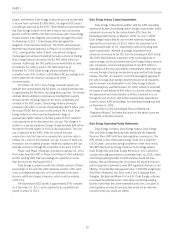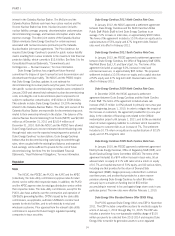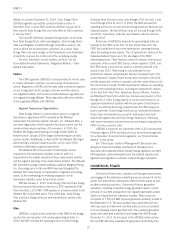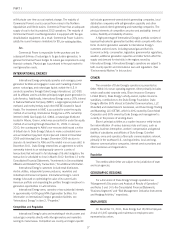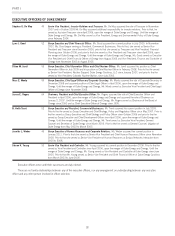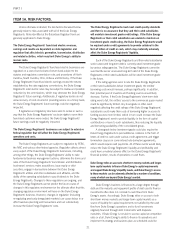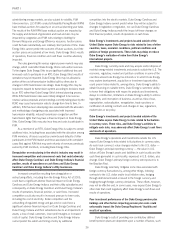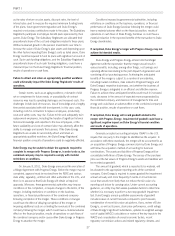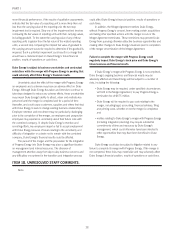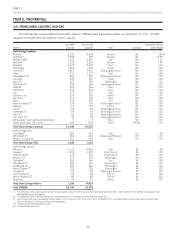Duke Energy 2011 Annual Report Download - page 40
Download and view the complete annual report
Please find page 40 of the 2011 Duke Energy annual report below. You can navigate through the pages in the report by either clicking on the pages listed below, or by using the keyword search tool below to find specific information within the annual report.
PART I
Other. The remainder of Duke Energy Ohio’s operations is
presented as Other. Although it is not considered a business segment,
Other primarily consists of certain governance costs allocated by its
ultimate parent, Duke Energy.
Duke Energy Indiana.
Duke Energy Indiana, an Indiana corporation organized in
1942, is a wholly-owned subsidiary of Cinergy. Duke Energy Indiana
generates, transmits and distributes electricity in central, north
central, and southern Indiana. Duke Energy Indiana is subject to the
regulatory provisions of the IURC and FERC. Duke Energy Indiana
operates one reportable business segment, Franchised Electric, which
generates, transmits, distributes and sells electricity. The substantial
majority of Duke Energy Indiana’s operations are regulated and
qualify for regulatory accounting treatment. For additional information
regarding this business segment, including financial information, see
Note 3 to the Consolidated Financial Statements, “Business
Segments.”
Duke Energy Indiana’s service area covers 23,000 square miles
with an estimated population of 3.0 million. Duke Energy Indiana
supplies electric service to 790,000 residential, commercial and
industrial customers. See Item 2. “Properties” for further discussion of
Duke Energy Indiana’s generating facilities, transmission and
distribution.
The remainder of Duke Energy Indiana’s operations is presented
as Other. Although it is not considered a business segment, Other
primarily includes certain governance costs allocated by its ultimate
parent, Duke Energy.
ENVIRONMENTAL MATTERS
TheDukeEnergyRegistrantsaresubjecttofederal,stateand
local laws and regulations with regard to air and water quality,
hazardous and solid waste disposal and other environmental matters.
Duke Energy is also subject to international laws and regulations with
regard to air and water quality, hazardous and solid waste disposal
and other environmental matters. Environmental laws and regulations
affecting the Duke Energy Registrants include, but are not limited to:
• The Clean Air Act (CAA), as well as state laws and regulations
impacting air emissions, including State Implementation Plans
related to existing and new national ambient air quality
standards for ozone and particulate matter. Owners and/or
operators of air emission sources are responsible for obtaining
permits and for annual compliance and reporting.
• The Clean Water Act which requires permits for facilities that
discharge wastewaters into the environment.
• The Comprehensive Environmental Response, Compensation
and Liability Act, which can require any individual or entity
that currently owns or in the past may have owned or
operated a disposal site, as well as transporters or generators
of hazardous substances sent to a disposal site, to share in
remediation costs.
• The Solid Waste Disposal Act, as amended by the Resource
Conservation and Recovery Act, which requires certain solid
wastes, including hazardous wastes, to be managed pursuant
to a comprehensive regulatory regime.
• The National Environmental Policy Act, which requires federal
agencies to consider potential environmental impacts in their
decisions, including siting approvals.
See “Other Issues” section of Management’s Discussion and
Analysis of Financial Condition and Results of Operations for a
discussion about potential Global Climate Change legislation and the
potential impacts such legislation could have on the Duke Energy
Registrants’ operations. Additionally, other recently passed and
potential future environmental laws and regulations could have a
significant impact on the Duke Energy Registrants’ results of
operations, cash flows or financial position. However, if and when
such laws and regulations become effective, the Duke Energy
Registrants will seek appropriate regulatory recovery of costs to
comply within its regulated operations.
For more information on environmental matters involving the
Duke Energy Registrants, including possible liability and capital costs,
see Notes 4 and 5 to the Consolidated Financial Statements,
“Regulatory Matters,” and “Commitments and Contingencies—
Environmental,” respectively. Except to the extent discussed in Note 4
to the Consolidated Financial Statements, “Regulatory Matters,” and
Note 5 to the Consolidated Financial Statements, “Commitments and
Contingencies,” compliance with current international, federal, state
and local provisions regulating the discharge of materials into the
environment, or otherwise protecting the environment, is incorporated
into the routine cost structure of our various business segments and is
not expected to have a material adverse effect on the competitive
position, consolidated results of operations, cash flows or financial
position of the Duke Energy Registrants.
20


